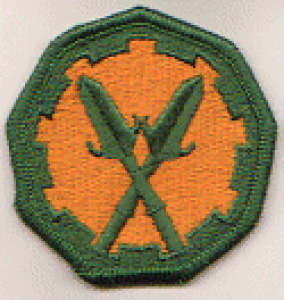Всемирная военная энциклопедия
> США
> Нашивки
> Нарукавные нашивки Сухопутных войск
> Военная полиция
> US-MPPTUS-00018

Нарукавный знак 290 бригады военной полиции СВ США
Случайные:

7-й механизированный полк

Погон старшего лейтенанта Вооруженных Сил России

Combat Infantryman Badge ( CIB) 2nd award
Редактировать или перевести информацию
Description
On a green nonagon, one point up, 2 7/16 inches (6.19 cm) in height and 2 7/16 inches (6.19 cm) in width overall, a yellow disk with embattled circumference bearing two green partisans, the upper shafts issuing saltirewise from two crenels in base.
Symbolism
Green and yellow are colors used for the Military Police Corps. The circular embattled central area indicates Prisoner of War Camps and military security facilities whose operations are commanded, planned, and supervised by the Brigade. The interior area also simulates the sun, symbolic of dissemination of knowledge, and refers to the Prisoner of War/Civilian Internee Information Center. The partisans, medieval weapons associated with guards, denote the guards provided for prisoners in confinement and for the security guard of military installations and facilities; the partisans are crossed to suggest control of the entrance and exit involved in the reception, search, and processing functions. Additionally, the two partisans (2), nine sides of the nonagon (9), and the circular center (0), allude to the numerical designation of the Brigade.
Background
The shoulder sleeve insignia was approved on 11 April 1972. (TIOH Dwg. No. A-1-551)
On a green nonagon, one point up, 2 7/16 inches (6.19 cm) in height and 2 7/16 inches (6.19 cm) in width overall, a yellow disk with embattled circumference bearing two green partisans, the upper shafts issuing saltirewise from two crenels in base.
Symbolism
Green and yellow are colors used for the Military Police Corps. The circular embattled central area indicates Prisoner of War Camps and military security facilities whose operations are commanded, planned, and supervised by the Brigade. The interior area also simulates the sun, symbolic of dissemination of knowledge, and refers to the Prisoner of War/Civilian Internee Information Center. The partisans, medieval weapons associated with guards, denote the guards provided for prisoners in confinement and for the security guard of military installations and facilities; the partisans are crossed to suggest control of the entrance and exit involved in the reception, search, and processing functions. Additionally, the two partisans (2), nine sides of the nonagon (9), and the circular center (0), allude to the numerical designation of the Brigade.
Background
The shoulder sleeve insignia was approved on 11 April 1972. (TIOH Dwg. No. A-1-551)
Еще из категории: Военная полиция
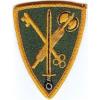 Нарукавный знак 42 бригады военной полиции СВ США
Нарукавный знак 42 бригады военной полиции СВ США
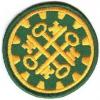 Нарукавный знак 177 бригады военной полиции СВ США
Нарукавный знак 177 бригады военной полиции СВ США
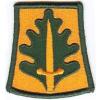 Нарукавный знак 333 бригады военной полиции СВ США
Нарукавный знак 333 бригады военной полиции СВ США
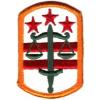 Нарукавный знак 260 командования военной полиции СВ США
Нарукавный знак 260 командования военной полиции СВ США
 Нарукавный знак 200 командования военной полиции СВ США
Нарукавный знак 200 командования военной полиции СВ США

